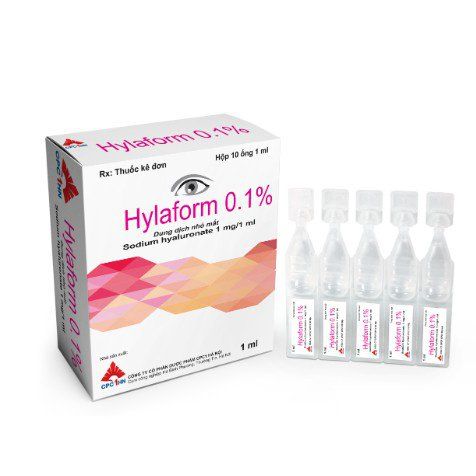This is an automatically translated article.
Bacitracin contains the active ingredient Bacitracin - an antibiotic belonging to the polypeptide group. The drug is indicated in the treatment of infections caused by susceptible bacteria such as conjunctivitis, keratitis, skin infections caused by susceptible bacteria. Let's learn about the uses and notes when using Bacitracin through the article below.1. Uses of the drug Bacitracin
What does Bacitracin do? The drug is prepared in the form of eye ointment, topical ointment and powder for injection. Bacitracin is indicated in the following cases:Local route:
Eye infections: Cleft palate, blepharitis, blepharitis, corneal ulcer, acute and chronic conjunctivitis, lacrimal sac, keratitis ; Skin infections: Superficial infections caused by susceptible bacteria. Systemic route:
Currently, the antibiotic Bacitracin is hardly indicated for the systemic route, if any, it is only used in the treatment of pneumonia in children and purulent effusion occurring due to staphylococci in young children; Bacitracin is used orally in the treatment of colitis caused by Clostridium difficile, but has now been replaced by oral vancomycin or metronidazole. Bacitracin is contraindicated in patients with a history of hypersensitivity to Bacitracin or any of its ingredients.
2. Dosage of the drug Bacitracin
2.1. Dosage: Bacitracin is used to treat bacterial infections with the following recommended doses:
Adults:
Oral drugs: Treatment of diarrhea caused by Clostridium difficile in adults at a dose of 20,000 - 25,000 units. /time, repeat oral dose after 6 hours, treatment time lasts from 7-10 days; Topical drugs: Apply to the skin from 1 to 5 times / day. For ophthalmic ointment, apply 1 strip (about 1cm) containing 500 units/g to the conjunctiva, repeat the dose after 3-4 hours in case of acute inflammation, or use 2-3 times/day in case of acute inflammation. In mild cases of inflammation, the duration of treatment lasts from 7-10 days. Ophthalmic ointment can be applied to the eyelid margin if blepharitis or blepharitis is present; Drugs for irrigation: Mix the drug solution with a concentration of 50-100 units/ml with 0.9% sodium chloride solution, sterile distilled water or Ringer Lactate solution for irrigation. Use gauze soaked in the drug solution, irrigate 1 - 5 times / day or when necessary to perform the procedure. Children: Use intramuscularly in the treatment of pneumonia in neonates or emphysema caused by staphylococci sensitive to the antibiotic Bacitracin. The recommended dose of Bacitracin is as follows:
Newborns weighing less than 2.5kg: Inject 900 units/kg/day divided into 2-3 doses; Neonates weighing 2.5 kg or more: Inject 1000 units/kg/day in 2-3 divided doses. The dose of the drug does not exceed the prescribed dose and does not last more than 12 days of treatment. Other subjects:
Patients with liver failure: No need to adjust the dose of Bacitracin; Renal Impairment: Discontinue use in case of any renal dysfunction. The drug can cause tubular necrosis, glomerular necrosis. 2.2. How to use Bacitracin For intramuscular injection, it is necessary to inject into the upper and outer 1⁄4 corner of the buttocks, the position of each injection should be changed to avoid pain after injection; Oral tablet form is only used in hospitals under the guidance of medical staff; Powder for injection should be mixed with 0.9% sodium chloride solution containing 2% procaine hydrochloride.
3. Side effects of the drug Bacitracin
Common:
Drugs for systemic use: Renal failure due to tubular necrosis, glomerular necrosis. Pain at the injection site, vomiting and nausea may occur, hypersensitivity reactions including hypersensitivity, rash; Topical drugs: Low toxicity. Uncommon: Hypersensitivity reactions, skin rash.
4. Note when using the drug Bacitracin
For the topical form of the drug, Bacitracin may cause delayed allergic reactions including anaphylaxis in hypersensitivity patients. Therefore, caution should be exercised when using the drug in open wounds.
Bacitracin drug absorbed through the bladder, wound, abdominal fluid can lead to side effects although toxicity is common when combined with Neomycin. Bacitracin is often used in combination with Polymycin B and Neomycin, so do not use the drug for more than 7 days.
Bacitracin drug administered intramuscularly causes much nephrotoxicity, renal failure due to tubular and glomerular necrosis. Patients should be checked for renal function before and periodically during treatment with the drug. In case of nephrotoxicity, the drug should be discontinued immediately.
Avoid combined use of Bacitracin with nephrotoxic drugs such as Streptomycin, Polymycin A, Polymycin B, Neomycin...
Note in pregnant women: Bacitracin belongs to group C in pregnancy classification when used by sugar Body. Therefore, the drug should not be used in pregnant women.
Note in lactating women: Do not use Bacitracin in women who are breastfeeding.
5. Drug interactions
Using Bacitracin in combination with the following drugs will increase nephrotoxicity: Kanamycin, Colistin, Streptomycin, Neomycin, Polymycin. The drug enhances the neuroblocking effect of some drugs with anesthetic and neuromuscular blocking effects, anesthetics used in surgery or after surgery. Bacitracin injection solution will be precipitated by solutions containing heavy metal salts, solutions containing parabens and inactivated by salicylates, benzoates, cetylpyridinium, benzalkonium, sodium lauryl sulfate, phenol and ichtammol. Drug interactions can occur that reduce the therapeutic effect of the drug, increasing the risk of unwanted effects. Patients need to inform the treating doctor of all medicines they are using including prescription drugs, dietary supplements, and over-the-counter drugs before taking Bacitracin.
Please dial HOTLINE for more information or register for an appointment HERE. Download MyVinmec app to make appointments faster and to manage your bookings easily.













